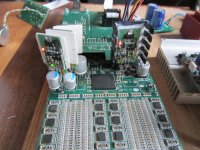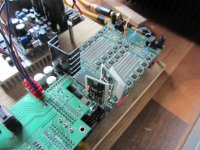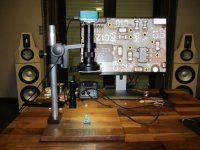lost me here......
what caps did u end up using?
4 pin or sometimes called T network capacitor. They 2 In pins +/- and 2 out pint +/-. Normally rectified AC current goes directly to the circuit. With four pins cap it always goes through the plate of capacitor which helps filtering out ac noise.
Just idea that I wanted to share with everyone.
I found Modulus-86 and Modulus-286 Amplifiers from Neurochrome mating very well with Soekris. I have it connected through RAW outputs, skipping onboard opamps.
Modulus have spectacular THD e.g.: THD+N - 0.00041% @ 65 W, 4 Ω, 1 kHz
You can find about modulus on separate threads of this forum.
Modulus is so small that it actually could be fitted in one case together with soekris and RPi.
I found Modulus-86 and Modulus-286 Amplifiers from Neurochrome mating very well with Soekris. I have it connected through RAW outputs, skipping onboard opamps.
Modulus have spectacular THD e.g.: THD+N - 0.00041% @ 65 W, 4 Ω, 1 kHz
You can find about modulus on separate threads of this forum.
Modulus is so small that it actually could be fitted in one case together with soekris and RPi.
Last edited:
Just idea that I wanted to share with everyone.
I found Modulus-86 and Modulus-286 Amplifiers from Neurochrome mating very well with Soekris. I have it connected through RAW outputs, skipping onboard opamps.
Modulus have spectacular THD e.g.: THD+N - 0.00041% @ 65 W, 4 Ω, 1 kHz
You can find about modulus on separate threads of this forum.
Modulus is so small that it actually could be fitted in one case together with soekris and RPi.
yea that could work well
wouldn't use a rpi, well not without some sort of i2s reclocker
yea that could work well
wouldn't use a rpi, well not without some sort of i2s reclocker
It actually works great
And of course Modulus works better when powered with -/+15V shunts
ALLO – KALI I2S RECLOCKER seems to makes wonders for RPi.
However I stayed with my audio PC. I build my own 12V PSU based on belleson regulators. One for CPU other for Pico PSU. USB PPA card is powered with shunt. Found that turning off sata helps, so I use ubuntu live usb booted entirely into RAM. This works great. Also xmos xu-216 on dac side makes wonders.
I use PC mainly due to its usability: tidal, netflix, youtube, spotify, flacs, jrvier, movies ... everything under your hand in one place with nice UI and UX.
People seems to keep forgetting that the dam1021 already is reclocking, two reclockers are redundant....
still makes a difference.....
people can always try for themselves though
I found Modulus-86 and Modulus-286 Amplifiers from Neurochrome mating very well with Soekris. I have it connected through RAW outputs, skipping onboard opamps.
I believe the mod86 takes balanced input. Are you using two dam1021 boards for balanced dual mono, or a single dam1021 with a pseudo-balanced cable?
I believe the mod86 takes balanced input. Are you using two dam1021 boards for balanced dual mono, or a single dam1021 with a pseudo-balanced cable?
I use pseudo balance cable.
People seems to keep forgetting that the dam1021 already is reclocking, two reclockers are redundant....
still makes a difference.....
people can always try for themselves though
I do agree with nige2000. Although dam1021 does reclocking it is still depadpant on quality/jitter of digital signal coming in.
In this case what counts most is quality of: usb->i2s and pci->usb card devices.
In theory isolation and reclocking should eliminate all jitter and noise problems but:
Connect soekris through USB to high quality audio PC and compare it to connecting it to e.g.: Rpi 3 through USB. You will get completely different sound.
Use better or worse PSU for audio PC and you will get completely different quality of sound.
Use xmos old xmos xu208 against newest xu216 and again sound will be different.
I'd love to hear the explanation as to why the sonic signature supposedly is different.
Digital signals are different animals compared to analogue ditos. Either the signal is corrupt = computer broken, or the dam is unable to handle very basic digital signal reception? Sœren doesn't strike me as someone unable to build a functioning interface? I like learning new stuff, please educate me in the theory behind this.
Why would an external reclocking unit be any better at receiving the signal? Why would a computer PSU matter as long as it's specs are within tolerances?
I gladly accept the possibility of me being wrong but audiophiles often seem to have trouble letting go of the analogue heritage. The whole point of going digital is the concept of "good enough".
Digital signals are different animals compared to analogue ditos. Either the signal is corrupt = computer broken, or the dam is unable to handle very basic digital signal reception? Sœren doesn't strike me as someone unable to build a functioning interface? I like learning new stuff, please educate me in the theory behind this.
Why would an external reclocking unit be any better at receiving the signal? Why would a computer PSU matter as long as it's specs are within tolerances?
I gladly accept the possibility of me being wrong but audiophiles often seem to have trouble letting go of the analogue heritage. The whole point of going digital is the concept of "good enough".
Last week I finished replacing the 4 onboard regulators 3.3v, 5v, -5v and 1.2v with muzgdiy regulators.
I glued some alumina ceramic pads on the back for better heat transfer, on the 1.2v I added an additional heatsink.
Result of this: better 3D soundstage, deeper, better separation between instruments/voices, more relaxed, ... all good
On the last picture you see the surgery table and my hdmi microscope that makes this minuscule soldering possible
I glued some alumina ceramic pads on the back for better heat transfer, on the 1.2v I added an additional heatsink.
Result of this: better 3D soundstage, deeper, better separation between instruments/voices, more relaxed, ... all good
On the last picture you see the surgery table and my hdmi microscope that makes this minuscule soldering possible
Attachments
Last week I finished replacing the 4 onboard regulators 3.3v, 5v, -5v and 1.2v with muzgdiy regulators.
I glued some alumina ceramic pads on the back for better heat transfer, on the 1.2v I added an additional heatsink.
Result of this: better 3D soundstage, deeper, better separation between instruments/voices, more relaxed, ... all good
On the last picture you see the surgery table and my hdmi microscope that makes this minuscule soldering possible
what u do with the vref?
My board is a v1, for the vref I did the lowresmod and plenty of polymer capacitors (32) on the back
ah ok
just seen the v1 board and wondered
Sören: On V3 / V4 boards - when adding caps, is there any OPTIMAL capacitance for the vref-design on these? Also, are the v-ref schematics like old but just different resistor/capacitor values or is there any other difference?
From rev2 and forward, the vref buffers use 0R1 and 499R/499R, giving a Zout of 0.05 ohm.
You can use as large capacitors as you want, but you will see diminishing returns above 500 uF per vref rail....
Last week I finished replacing the 4 onboard regulators 3.3v, 5v, -5v and 1.2v with muzgdiy regulators.
I glued some alumina ceramic pads on the back for better heat transfer, on the 1.2v I added an additional heatsink.
Result of this: better 3D soundstage, deeper, better separation between instruments/voices, more relaxed, ... all good
On the last picture you see the surgery table and my hdmi microscope that makes this minuscule soldering possible
On my setup I found similar was achieved just by replacing the 3.3V regulators with Sparko's discrete units, which makes some sense as this is powering the clock among other things. I've never bothered with the 5V regulators simply because of the far superior 4V vref circuits, which have no problem keeping ripple below ~0.1mV. (according to my scope anyway)
Hi Søren,From rev2 and forward, the vref buffers use 0R1 and 499R/499R, giving a Zout of 0.05 ohm.
You can use as large capacitors as you want, but you will see diminishing returns above 500 uF per vref rail....
I ordered two dam1021-12 rev4 boards yesterday. Would it be possible that you provide a short description of the actual version of your vref "factory mod"? What is useful, what isn't, regarding caps, resistors, etc.
I just read this blog https://hifiduino.wordpress.com/2015/07/12/soekris-dac-modding-vref/ and now I'm even more confused than before.
Thanks in advance
- Home
- Vendor's Bazaar
- Reference DAC Module - Discrete R-2R Sign Magnitude 24 bit 384 KHz


